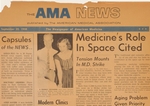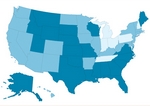Government
AARP renews campaign to close Medicare drug coverage gap
■ The senior advocacy group also calls on Congress to implement an approval pathway for generic biologics.
By Chris Silva — Posted June 8, 2009
- WITH THIS STORY:
- » Falling through the cracks
- » Related content
Washington -- As Congress considers comprehensive health system reform, AARP is reminding lawmakers of what it perceives to be a growing problem -- a coverage gap in the Medicare drug benefit that results in high prescription drug costs for some seniors.
This coverage gap, commonly referred to as the "doughnut hole," starts when initial government subsidies run out and ends when the program's catastrophic benefit kicks in. During this time beneficiaries must pay all of their drug costs, in addition to their monthly premiums.
Today, roughly 3.4 million Part D beneficiaries fall into the gap each year, but only 15% of those end up spending enough of their own money to hit the upper limit and receive catastrophic coverage, AARP said. The government covers nearly all medication costs after that occurs.
Lawmakers who designed the benefit said they allowed the coverage gap in order to avoid an incentive for seniors to spend more than they need to on drugs simply to hit the catastrophic limit more quickly. Saying that the gap was too large and would affect too many needy seniors, AARP has been calling for revisions since before the benefit launched in 2006.
According to research from the Kaiser Family Foundation, nearly all Part D plans have a coverage gap in 2009, which totals $3,454 in out-of-pocket spending for seniors enrolled in the standard Medicare Part D benefit (link). By 2016, that gap is expected to exceed $6,000 per beneficiary, a figure that AARP says is much too high.
"Prescription drug coverage has literally been a life-saver for people in Medicare, but the widening doughnut hole is still leaving too many Americans on their own to face skyrocketing drug costs," said Nancy LeaMond, AARP's executive vice president. "We know that higher costs lead people to skip doses or give up their prescriptions entirely, putting their health in jeopardy and driving up long-term costs."
Some poorer Part D enrollees can qualify for a low-income subsidy that generally covers their costs in the coverage gap. Approximately 4 million beneficiaries receive this additional help, though AARP is calling on lawmakers to expand eligibility.
In 2009, 25% of drug plans offer some type of additional coverage within the gap, according to the Kaiser report. That's down from 29% in 2008 but still higher than in the program's first year in 2006.
The need for more generics
Seniors facing high drug costs also would benefit from the market presence of generic versions of biologic drugs used to treat diseases such as cancer and multiple sclerosis, AARP said.
The U.S. currently does not have a standard approval process in place for the Food and Drug Administration to review generic biologics, which also are known as follow-ons or biosimilars. The FDA examines applications for these generics on a case-by-case basis, applying various sections of law depending on the nature of the drug.
AARP maintains that without generic competition, brand-name biologic drugmakers sometimes can charge thousands of dollars per month for the drugs, even for those that have been on the market for years.
"Since the 1980s, safe, affordable generic drugs have helped Americans save billions of dollars on their health care bills," said LeaMond. "With biologics now making up a large and growing share of the market, it's time to bring those same savings to people taking these breakthrough drugs while protecting medical innovation."
The National Multiple Sclerosis Society also supports an approval pathway for generic biologics. The group says that some multiple sclerosis medications cost $30,000 or more per year.
"We've known of people altering their dosages because of the costs," said Shawn O'Neail, the society's vice president of federal government relations. "We think it would be irresponsible to not allow the FDA to approve generics when they are available and when they are safe and effective."
President Obama has shown his support for the generic biologics effort. His 2010 budget resolution calls for the establishment of a workable scientific pathway for accelerated FDA approval of the drugs. Expanding access to the medications would lead to Medicare and Medicaid savings, the administration has said.
Lawmakers have introduced legislation to create an approval process for generic biologics. The Promoting Innovation and Access to Life-Saving Medicine Act, reintroduced March 11 by House Energy and Commerce Committee Chair Henry Waxman (D, Calif.), is the version AARP favors. Senate companion legislation was introduced March 26 by Sen. Charles Schumer (D, N.Y.).
A competing bill, the Pathway for Biosimilars Act, was reintroduced March 17 by Rep. Anna Eshoo (D, Calif.).












